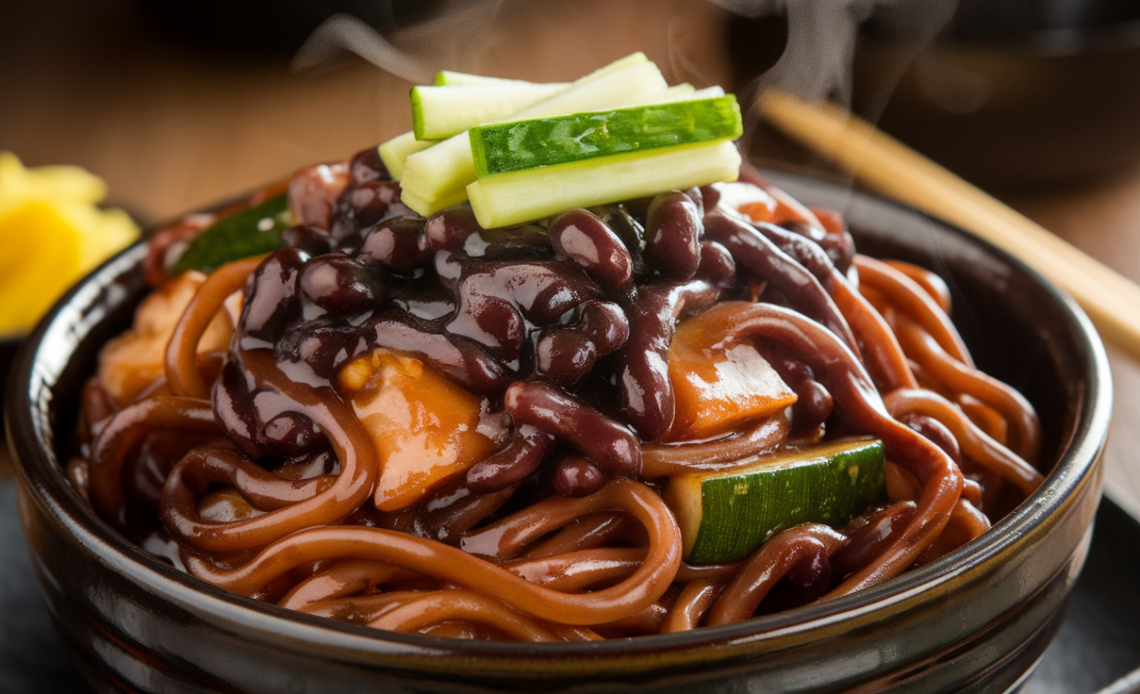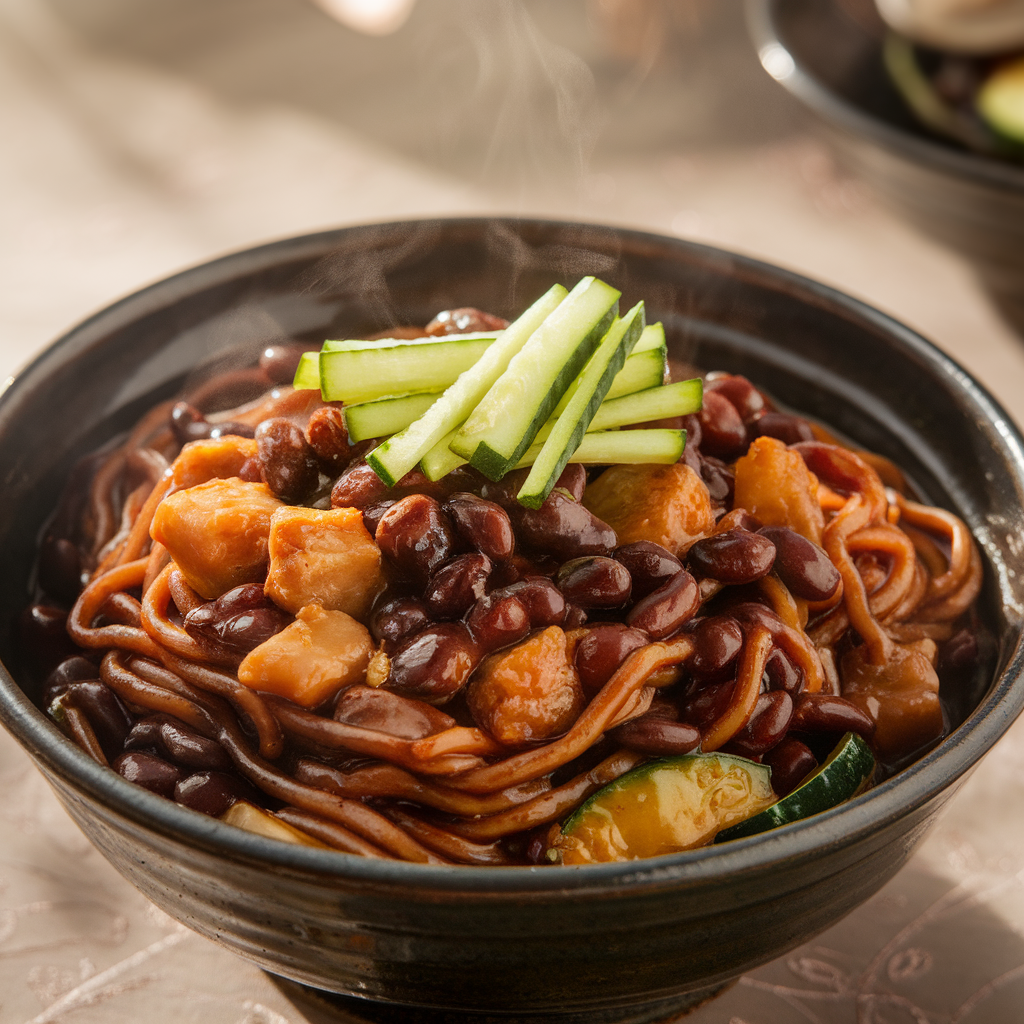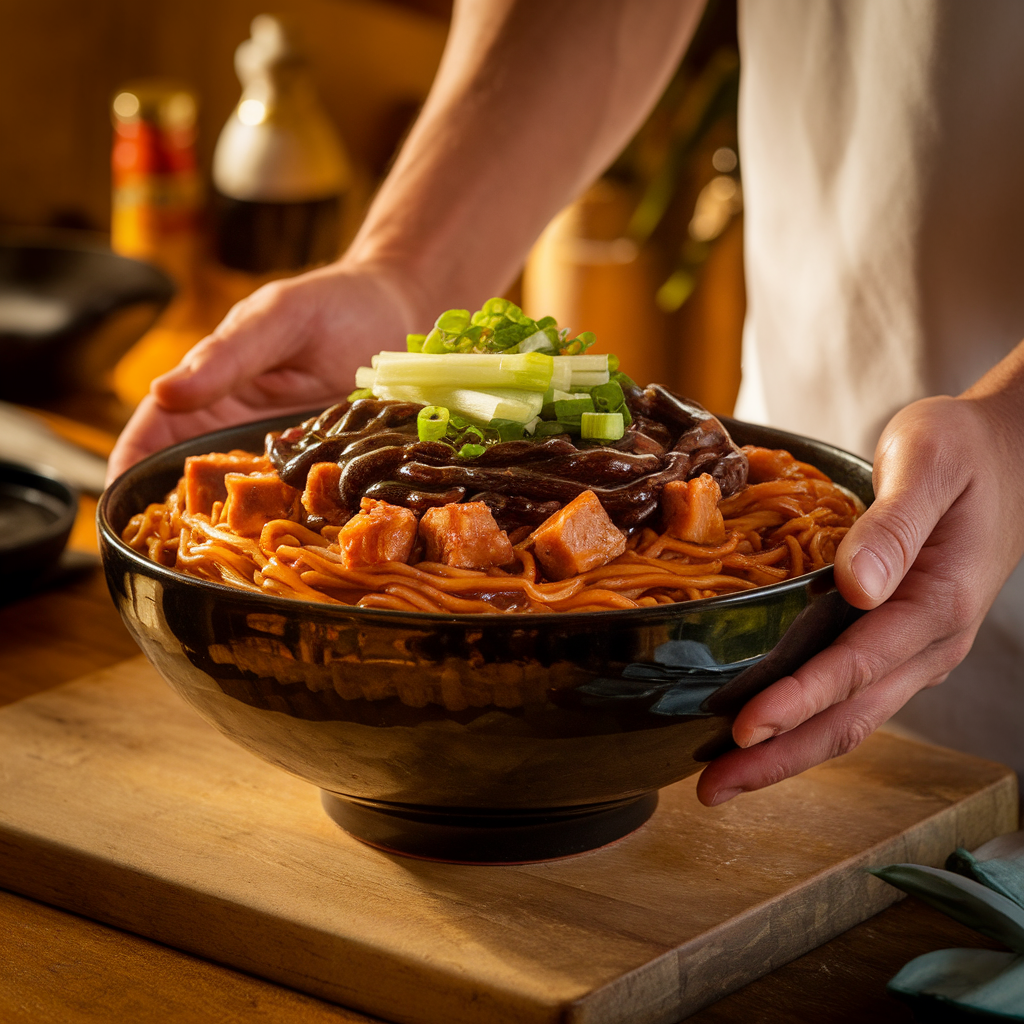
Jajangmyeon, also known as Korean black bean noodles, is one of the most iconic and beloved dishes in Korean cuisine. With its rich, savory black bean sauce coating thick, chewy noodles, Jajangmyeon delivers the perfect blend of sweet, salty, and umami flavors. Whether you’re already a fan of Korean noodle dishes or just starting to explore Asian cooking, this recipe will walk you through how to make Korean black bean noodles from scratch—with plenty of helpful tips and background along the way.
In this detailed recipe guide, we’ll cover:
- What is Jajangmyeon?
- The difference between Korean and Chinese black bean noodles
- Essential ingredients
- Step-by-step instructions
- Tips for perfect noodles every time
- How to customize Jajangmyeon
- What to serve with black bean noodles
- A deep dive into the cultural significance of Jajangmyeon
- Storage, reheating, and variations
- Plus: relevant hashtags to share your noodle masterpiece!
🍜 What is Jajangmyeon?
Jajangmyeon (짜장면) is a Korean-Chinese noodle dish made with thick wheat noodles topped with a deeply flavorful sauce made from chunjang (a fermented black soybean paste), diced pork (or sometimes beef), and a medley of vegetables like onion, zucchini, and cabbage.
It originated as a Korean adaptation of the Chinese dish zhajiangmian (炸酱面), but over time, Jajangmyeon developed its own unique flavor profile and cultural significance in Korea.
Today, Jajangmyeon is a go-to comfort food and a staple of Korean takeout culture—commonly eaten during celebrations, after a long workday, or even on Black Day (April 14), when single people in Korea gather to eat black foods in solidarity.

🍲 What’s the Difference Between Korean and Chinese Black Bean Noodles?
Though they share roots, Korean Jajangmyeon differs significantly from Chinese zhajiangmian. The Korean version uses chunjang, which is sweeter and more fermented than its Chinese counterpart. The sauce in Jajangmyeon is also often thickened with cornstarch and has a more balanced sweetness, which sets it apart from the salty and pungent zhajiangmian sauce.
Korean Jajangmyeon:
- Uses chunjang (fermented Korean black bean paste)
- Sweet, mild, and rich flavor
- Often includes diced pork belly, onions, zucchini, cabbage
- Thick sauce with cornstarch slurry
Chinese Zhajiangmian:
- Uses doubanjiang or tianmianjiang
- Salty and bold
- Often includes ground pork and fermented soybeans
- Less sweet and thinner in texture
🛒 Ingredients for Jajangmyeon Black Bean Noodles
Here’s everything you need to prepare authentic Korean black bean noodles at home:
For the Noodles:
- 1 lb fresh Korean wheat noodles (or thick udon-style noodles)
- Water for boiling
- Salt (optional)
For the Black Bean Sauce:
- 2 tablespoons vegetable oil
- 1/2 pound pork belly or shoulder (cubed)
- 1 onion, diced
- 1/2 zucchini, diced
- 1/2 potato, peeled and diced
- 1/2 cup cabbage, chopped
- 2 tablespoons chunjang (Korean black bean paste)
- 1 tablespoon sugar (adjust to taste)
- 1 ½ cups chicken or vegetable broth
- 1 tablespoon oyster sauce (optional for depth)
- 1 tablespoon soy sauce
- 1 tablespoon cornstarch mixed with 2 tablespoons water (slurry)
For Garnish:
- Thinly sliced cucumber or green onions
- Sesame seeds (optional)
- Fried egg (optional for extra richness)

🧑🍳 How to Make Korean Black Bean Noodles (Step-by-Step)
Step 1: Prepare the Noodles
- Boil a large pot of water.
- Cook the noodles according to the package instructions (usually 5–7 minutes).
- Rinse under cold water, drain well, and set aside.
Step 2: Cook the Pork and Vegetables
- In a large skillet or wok, heat 1 tablespoon of oil over medium-high heat.
- Add the cubed pork and stir-fry until browned and crispy.
- Remove any excess fat if needed, then add onions, potatoes, zucchini, and cabbage.
- Stir-fry for 5–7 minutes until the vegetables are slightly soft.
Step 3: Make the Black Bean Sauce
- Push the vegetables and pork to one side of the skillet.
- Add another tablespoon of oil to the empty side and stir in the chunjang paste.
- Cook the paste for 1–2 minutes to reduce bitterness and deepen the flavor.
- Mix everything together, then add the sugar, soy sauce, and optional oyster sauce.
- Pour in the broth and bring to a simmer.
- Cook for 8–10 minutes until vegetables are tender and the flavors meld.
Step 4: Thicken the Sauce
- Stir in the cornstarch slurry.
- Simmer for another 2–3 minutes until the sauce is thick and glossy.
Step 5: Assemble the Dish
- Place cooked noodles in serving bowls.
- Pour the black bean sauce generously over the noodles.
- Top with julienned cucumber, sesame seeds, and a fried egg if desired.
🔍 Tips for the Best Jajangmyeon
- Fry the chunjang paste before mixing with other ingredients—this removes bitterness.
- Use fresh noodles if possible. Dried noodles work but may lack the same chew.
- Add a touch of sugar to balance the salty paste—don’t skip it!
- Customize with seafood or make it vegetarian with mushrooms and tofu.
- Leftovers? The sauce tastes even better the next day.
🍽 What to Serve with Korean Black Bean Noodles
Here are some tasty Korean side dishes and drinks to complement your Jajangmyeon:
- Kimchi – adds a spicy, fermented contrast
- Danmuji (yellow pickled radish) – classic pairing for Jajangmyeon
- Black Bean Tteokbokki – for a spicy twist on Korean rice cakes
- Korean cucumber salad (Oi Muchim) – fresh and tangy
- Korean fried chicken – if you’re feeling indulgent
- Iced barley tea (boricha) – a refreshing nonalcoholic drink to cleanse the palate

🥢 Jajangmyeon Cultural Spotlight: More Than Just Noodles
Jajangmyeon is more than just a delicious dish—it holds a special place in Korean pop culture and modern life.
- Black Day Tradition: On April 14th, single Koreans celebrate being unattached by eating Jajangmyeon with friends.
- Mukbang Favorite: This dish is a staple in Korean “eating shows” or mukbangs due to its glossy, slurpy appeal.
- Comfort Food Status: Jajangmyeon is the pizza or mac-and-cheese of Korea—comforting, easy to crave, and always satisfying.
🥡 Storage and Reheating Tips
Storage: Keep the noodles and sauce separate in airtight containers. Store in the fridge for up to 3 days.
Reheating: Gently reheat the sauce in a pan or microwave with a splash of water to loosen it. Reboil the noodles quickly or rinse them in hot water to refresh.
🌱 Variations & Customizations
Jajangmyeon is super versatile. Here’s how to switch things up:
1. Black Bean Fire Noodles
Add Korean chili flakes (gochugaru) or chili oil for spicy black bean noodles. Perfect for heat lovers!
2. Vegetarian or Vegan Version
Swap pork with diced tofu, mushrooms, or plant-based meat. Use vegetable broth instead of chicken broth.
3. Seafood Jajangmyeon
Add shrimp, squid, or mussels for a luxurious ocean-inspired twist.
4. Black Bean Pasta
Use spaghetti or linguine instead of Korean noodles for a Korean-Italian fusion.
📱 Share Your Jajangmyeon Creation
Don’t forget to capture and share your delicious noodle bowl online! Use these hashtags to reach other Korean food fans:
💬 Final Thoughts
Jajangmyeon is a dish that combines tradition, flavor, and comfort in one perfect bowl. Whether you’re trying Korean food for the first time or looking to recreate your favorite takeout at home, this Jajangmyeon black bean noodles recipe delivers. The balance of textures and flavors, along with its cultural backstory, makes it a must-try.
Plus, once you master this recipe, the possibilities are endless. From spicy versions to fusion twists, Jajangmyeon offers the perfect foundation for creative experimentation.
So grab your chopsticks, slurp those noodles, and savor every bite of Korea’s favorite black bean comfort food.




